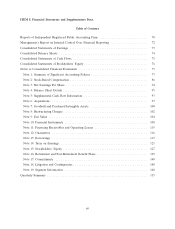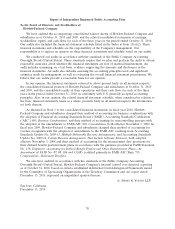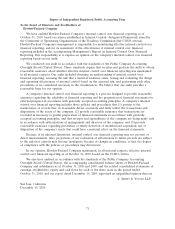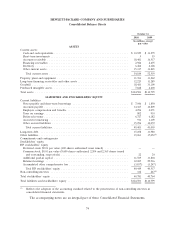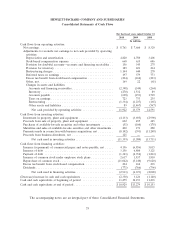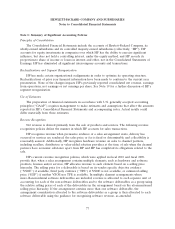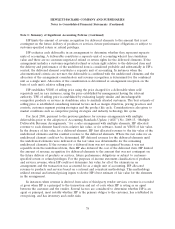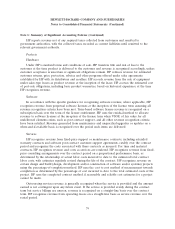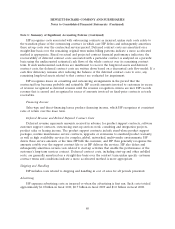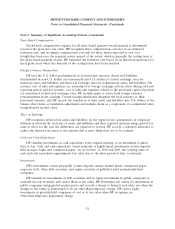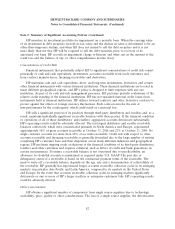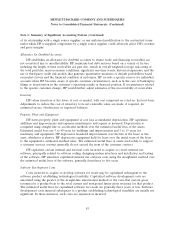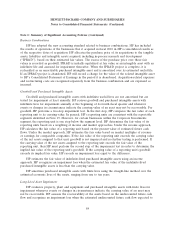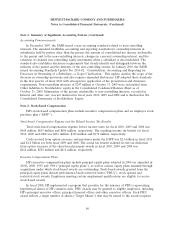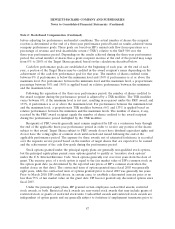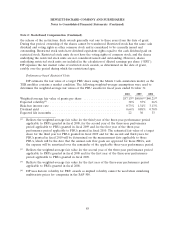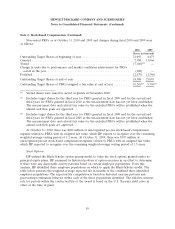HP 2010 Annual Report Download - page 87
Download and view the complete annual report
Please find page 87 of the 2010 HP annual report below. You can navigate through the pages in the report by either clicking on the pages listed below, or by using the keyword search tool below to find specific information within the annual report.HEWLETT-PACKARD COMPANY AND SUBSIDIARIES
Notes to Consolidated Financial Statements (Continued)
Note 1: Summary of Significant Accounting Policies (Continued)
HP reports revenue net of any required taxes collected from customers and remitted to
government authorities, with the collected taxes recorded as current liabilities until remitted to the
relevant government authority.
Products
Hardware
Under HP’s standard terms and conditions of sale, HP transfers title and risk of loss to the
customer at the time product is delivered to the customer and revenue is recognized accordingly, unless
customer acceptance is uncertain or significant obligations remain. HP reduces revenue for estimated
customer returns, price protection, rebates and other programs offered under sales agreements
established by HP with its distributors and resellers. HP records revenue from the sale of equipment
under sales-type leases as product revenue at the inception of the lease. HP accrues the estimated cost
of post-sale obligations, including basic product warranties, based on historical experience at the time
HP recognizes revenue.
Software
In accordance with the specific guidance for recognizing software revenue, where applicable, HP
recognizes revenue from perpetual software licenses at the inception of the license term assuming all
revenue recognition criteria have been met. Term-based software license revenue is recognized on a
subscription basis over the term of the license entitlement. HP uses the residual method to allocate
revenue to software licenses at the inception of the license term when VSOE of fair value for all
undelivered elements exists, such as post-contract support, and all other revenue recognition criteria
have been satisfied. Revenue generated from maintenance and unspecified upgrades or updates on a
when-and-if-available basis is recognized over the period such items are delivered.
Services
HP recognizes revenue from fixed-price support or maintenance contracts, including extended
warranty contracts and software post-contract customer support agreements, ratably over the contract
period and recognizes the costs associated with these contracts as incurred. For time and material
contracts, HP recognizes revenue and costs as services are rendered. HP recognizes revenue from fixed-
price consulting arrangements over the contract period on a proportional performance basis, as
determined by the relationship of actual labor costs incurred to date to the estimated total contract
labor costs, with estimates regularly revised during the life of the contract. HP recognizes revenue on
certain design and build (design, development and/or construction of software and/or systems) projects
using the percentage-of-completion method. HP uses the cost to cost method of measurement towards
completion as determined by the percentage of cost incurred to date to the total estimated costs of the
project. HP uses the completed contract method if reasonable and reliable cost estimates for a project
cannot be made.
Outsourcing services revenue is generally recognized when the service is provided and the amount
earned is not contingent upon any future event. If the service is provided evenly during the contract
term but service billings are uneven, revenue is recognized on a straight-line basis over the contract
term. HP recognizes revenue from operating leases on a straight-line basis as service revenue over the
rental period.
79


